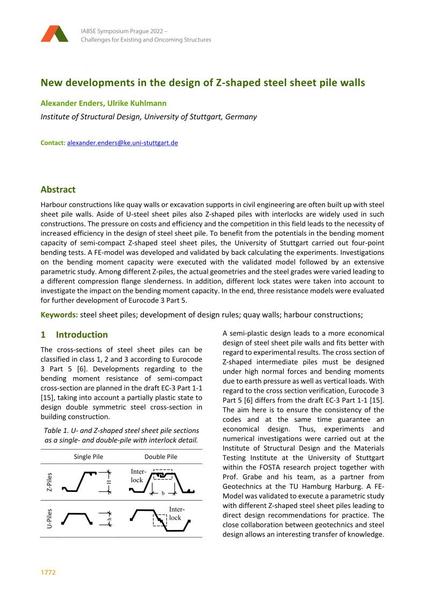New developments in the design of Z-shaped steel sheet pile walls

|
|
|||||||||||
Bibliographic Details
| Author(s): |
Alexander Enders
(Institute of Structural Design, University of Stuttgart, Germany)
Ulrike Kuhlmann (Institute of Structural Design, University of Stuttgart, Germany) |
||||
|---|---|---|---|---|---|
| Medium: | conference paper | ||||
| Language(s): | English | ||||
| Conference: | IABSE Symposium: Challenges for Existing and Oncoming Structures, Prague, Czech Republic, 25-27 May 2022 | ||||
| Published in: | IABSE Symposium Prague 2022 | ||||
|
|||||
| Page(s): | 1772-1779 | ||||
| Total no. of pages: | 8 | ||||
| DOI: | 10.2749/prague.2022.1772 | ||||
| Abstract: |
Harbour constructions like quay walls or excavation supports in civil engineering are often built up with steel sheet pile walls. Aside of U-steel sheet piles also Z-shaped piles with interlocks are widely used in such constructions. The pressure on costs and efficiency and the competition in this field leads to the necessity of increased efficiency in the design of steel sheet pile. To benefit from the potentials in the bending moment capacity of semi-compact Z-shaped steel sheet piles, the University of Stuttgart carried out four-point bending tests. A FE-model was developed and validated by back calculating the experiments. Investigations on the bending moment capacity were executed with the validated model followed by an extensive parametric study. Among different Z-piles, the actual geometries and the steel grades were varied leading to a different compression flange slenderness. In addition, different lock states were taken into account to investigate the impact on the bending moment capacity. In the end, three resistance models were evaluated for further development of Eurocode 3 Part 5. |
||||
| Keywords: |
quay walls steel sheet piles development of design rules harbour constructions
|
||||
| Copyright: | © 2022 International Association for Bridge and Structural Engineering (IABSE) | ||||
| License: | This creative work is copyrighted material and may not be used without explicit approval by the author and/or copyright owner. |
||||
